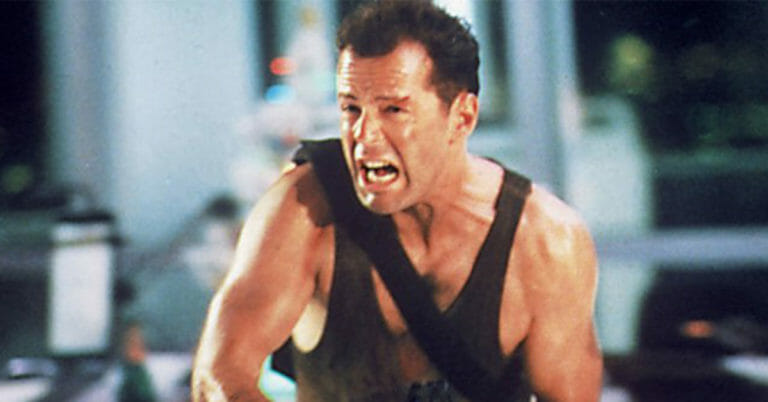By Valerie Kalfrin · October 12, 2018

An action film firing on all cylinders has a rush all its own. But that stems from more than adrenaline—it’s the satisfying payoff of a script that shares just enough backstory, builds strong characters, and orients us in its environment without going overboard.
These films are known for their memorable stunts, creative editing, special effects, and snappy one-liners, but none of that would gel without the setup that invests us in the story, as two action classics celebrating birthdays this year show. Die Hard, which turned thirty, and Run Lola Run, which turned 20, have vastly different storytelling styles. Die Hard is a linear thriller adapted from the 1979 novel Nothing Lasts Forever. Run Lola Run is a German independent film that mixes a Groundhog Day–style narrative with animation. But each stands the test of time because of how well it sets up its knockout moments.
Focusing on how to choreograph certain moves doesn’t make that happen. Highlighting what changes in the environment, the stakes, or characters as the story unfolds does.
“You have to be simple in your storytelling so the audience can follow it,” says David Mamet, whose advice for dramas like Glengarry Glen Ross also holds true for action films like Ronin, which turns 20 this year (and for which Mamet co-wrote the screenplay under the name Richard Weisz).
The audience is always a few steps ahead of you—it’s human nature to problem-solve, he says in his online MasterClass. So create tension by not revealing too much.
“They have to know what story they’re following so that they can be misled. You see, what we do when we listen to a story is, we jump ahead. We say, ‘Oh, yeah, I see what he’s gonna do,’ or ‘I don’t know what they’re gonna do; let me try and figure it out,’” Mamet says. “And then the next step is surprising and inevitable. Each scene is a simple attempt to solve the problem. The scene fails—it has to, or we wouldn’t go on to the next scene.”
Here’s how Die Hard and Run Lola Run set up each of their later surprises.
Within the first ten minutes of Die Hard, we know that John McClane (Bruce Willis) is a New York City detective who’s estranged from his wife, Holly (Bonnie Bedelia), working in Los Angeles. The script by Jeb Stuart (The Fugitive) and Steven E. de Souza (48 Hours) quickly establishes that it’s Christmas, that John doesn’t like to travel—and that he’s got a stubborn macho side. He tells limo driver Argyle (De’voreaux White) that he couldn’t just pack up and move, which Argyle sees through instantly.
“You mean you thought she wouldn’t make it out here and she’d come crawling on back, so why bother to pack?” he says.
McClane smiles in spite of himself. “Like I said, Argyle, you’re fast.”
Run Lola Run from writer-director Tom Twyker (The International) has a Choose Your Own Adventure narrative with three different outcomes, each a mini-movie comprising about twenty minutes of screen time. It sets up the overall predicament in the first eleven minutes, as Lola (Franka Potente, The Bourne Identity) receives a frantic, tearful phone call from her boyfriend, Manni (Moritz Bleibtreau, Woman in Gold). The aspiring hoodlum has messed up on a tryout, losing a bag of money for a crime boss on the subway; a bum picked up the cash after a spooked Manni saw police officers and left the train without it. He has twenty minutes to come up with 100,000 Deutschmarks, or he’s dead.
Lola urges him not to do anything foolish, like rob the grocery store near his phone booth. She says she’ll come up with something and will meet him—then runs down her apartment building’s stairwell, the starting point for how each narrative varies.
In Die Hard, McClane is the man in the wrong place at the wrong time—the unexpected guest at a Christmas party that robbers posing as terrorists crash to rob the corporation’s vault. McClane’s smart-aleck personality comes through in his dialogue, but the script also doles out early character touches that make him likable. He sits in the front of the limo with Argyle instead of in the back, not used to the luxury. He totes a giant plush bear on the plane for his children—but he’s a nervous flier, which a salesman next to him notices as the plane lands. This guy offers the helpful tip of making “fists with your toes” when you get to your destination, a nice way for McClane to wind up at a barefoot disadvantage later once he’s dodging bullets and glass.
Holly uses her maiden name on her office building’s directory, an independent touch that rankles him. She also turns the family photo facedown in her office after checking in with her children and housekeeper and learning that John didn’t call before he caught his flight.
In Run Lola Run, the dialogue and flashbacks endear Lola and Manni to us, even though they’re on the wrong side of the law. They live in a cluttered apartment and share a moped, which someone steals while Lola stops to buy cigarettes. The film also adds suspense for whether they’ll triumph when Manni says that he knew there would come a time when Lola wouldn’t know what to do. “You said, ‘Love can do everything,’” he says, raising the unspoken question of whether it can.
Suspense can fizzle through editing or direction that’s so frenetic, it’s tough to follow the action. (See the mountain chase in 2008’s Quantum of Solace, for instance.)
Through dialogue and visual touches over the first twenty minutes, Die Hard gives viewers a clear sense of the Nakatomi Corporation’s office building. From the lobby security guard, we learn the building is empty except for the Christmas party on the thirtieth floor. “Take the express elevator and get off at the noise,” the guard says.
We also know that Argyle is in the basement, albeit oblivious while on the phone and listening to music. He’s offered to stick around in case McClane’s reunion with Holly hits the rocks so he can drive John to a hotel, a setup that pays off later when he foils the robbers from escaping in a van.
Once the gunmen take the partygoers hostage, signs in the stairwell, as well as McClane’s muttering and the robbers’ dialogue, spell out what’s on each floor—construction, computers, the roof—again giving viewers a mental blueprint to follow. McClane also memorably sees a nude pinup in an area still under construction. He taps the poster after escaping from harm—a way for the audience to get its bearings while again underscoring his macho character.
In each segment of Run Lola Run, Lola runs to the bank where her father works to get the money Manni needs. But as each segment unfolds differently, so do the variations in passersby—a woman with a baby carriage, a bicyclist, a motorist—whose lives flash forward after their interactions with Lola.
Aside from touching on the film’s themes of fate and choices, these minor characters serve as signposts for viewers to follow the action. Even if we don’t recognize Lola’s cityscape, we know when we see the bicyclist that she’s near the bank.
Explore what backstory, character clues and landmarks you can add to your action script through small doses. Test yourself, as Mamet does, to see what little you need to convey a lot. “What can you do without? That’s the question,” he’s said. “Not what can you put in.”
Read More: The Best Action Comedy Movies That Kick Ass and Split Sides
 Valerie Kalfrin is an award-winning crime journalist who now dives into fictional mayhem as an author (Quicklet on The Closer: Season 1), essayist, film critic, screenwriter, and emerging script consultant. She also writes for The Guardian, Bright Wall Dark Room, ScreenCraft, Hazlitt, Signature, and the blog for Final Draft, the top-rated screenwriting software used by the filmmaking industry. A member of Screenwriters of Tomorrow, she’s collaborated on short films and features, and she’s affiliated with the Tampa Bay Film Society. She lives in Florida. Find her online at valeriekalfrin.com.
Valerie Kalfrin is an award-winning crime journalist who now dives into fictional mayhem as an author (Quicklet on The Closer: Season 1), essayist, film critic, screenwriter, and emerging script consultant. She also writes for The Guardian, Bright Wall Dark Room, ScreenCraft, Hazlitt, Signature, and the blog for Final Draft, the top-rated screenwriting software used by the filmmaking industry. A member of Screenwriters of Tomorrow, she’s collaborated on short films and features, and she’s affiliated with the Tampa Bay Film Society. She lives in Florida. Find her online at valeriekalfrin.com.
Photo credit: Die Hard
For all the latest from The Script Lab, be sure to follow us on Twitter, Facebook, and Instagram.